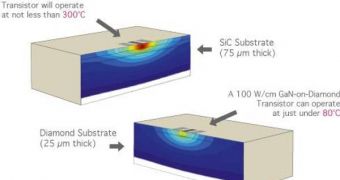Researchers at the University of Glasgow (UG) recently took the first place in the race to construct the world's smallest diamond transistor, when they constructed one only 50 nanometers in length. The new device is the work of UG Department of Electronics & Electrical Engineering expert Dr. David Moran and his team. The diamond transistor is approximately half the size of the second-smallest one, previously devised by the NTT Japanese enterprise. The expert now has all the reasons to be proud of his work, especially considering that diamonds are generally touted as being the logical choice for the next class of transistors, due to their amazing physical and chemical properties.
“From its invention in 1947, the transistor has been the building block of many modern day technologies, from silicon-based chips in your computer processor, to gallium arsenide based circuits in your mobile phone. These types of materials – silicon and gallium arsenide – are chosen upon what their strengths and weaknesses are. Diamond, on the other hand, is very much an excellent all-round performer, and has been described by many as a perfect material. By developing a diamond transistor technology, we aim to tap into the truly amazing properties of this exciting material, which could prove fundamental to the development of several next generation technologies,” PhysOrg quotes Moran as saying.
What makes the UG-developed transistor so powerful is the fact that its “gate” is only 50 nanometers long. These gates are used to regulate the way in which electrical current flows between two electrical contact points, and physical theories have it that the smaller the gate, the faster the transistor itself. Over the last year, as technologies developed, more and more of these devices were crammed on smaller and smaller chips, which meant that they had to be made even smaller. However, from a certain level of miniaturization onwards, quantum forces acting inside silicon-based transistors become simply too strong to allow for the device to function smoothly.
“These applications require a very fast and ideally high-power transistor technology that needs to be able to operate in adverse weather/temperature conditions. This is where a diamond transistor technology would excel,” Moran added. Researchers are constantly looking for new materials to replace silicon and gallium arsenide. In the future, chips will undoubtedly be made of carbon nanomaterials, as progress on this front is happening very fast. Still, a good time will pass before that technology becomes economically sustainable. In the meantime, diamond conductors will more likely take the place of existing ones.

 14 DAY TRIAL //
14 DAY TRIAL //